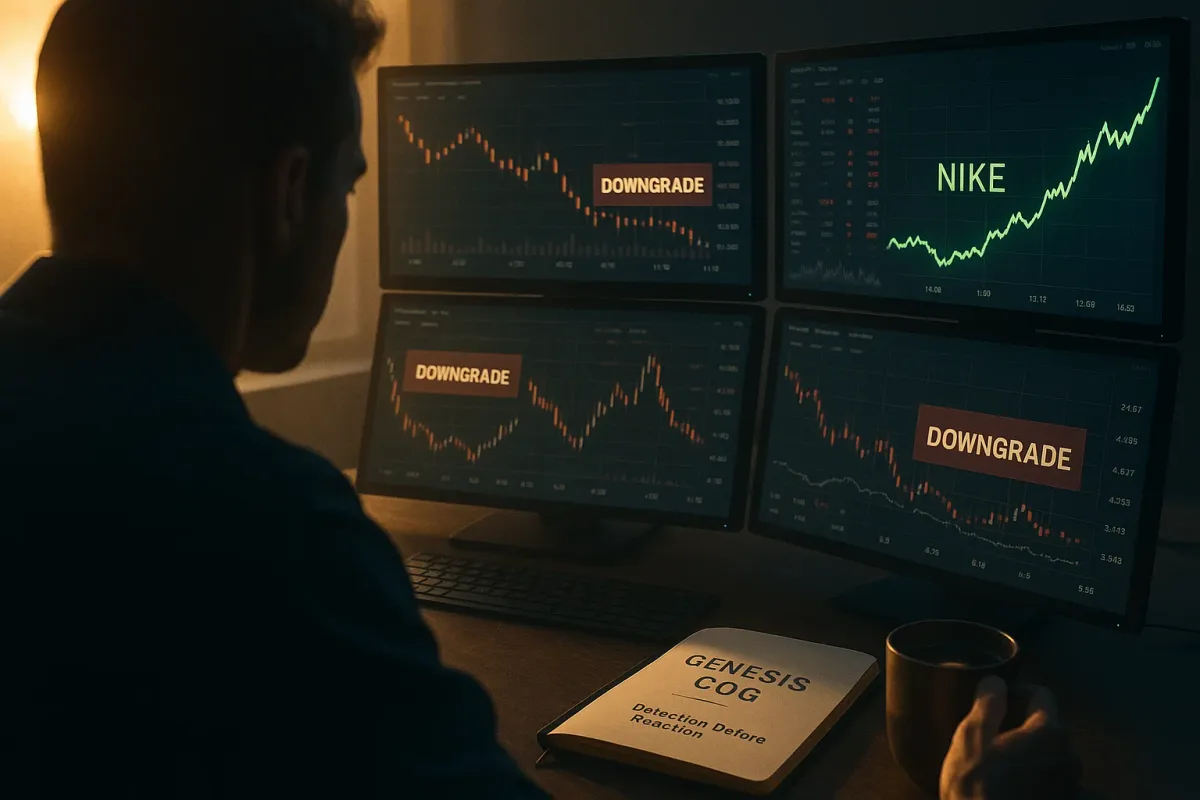The Machines That Move Wall Street

March 2025. Wall Street’s sharpest minds wrote their theses in ink: Nike was done. JPMorgan had hammered the final nail with a rare public downgrade. Every financial headline screeched, “Dead Money.” Hedge funds piled up short positions. Social feeds became echo chambers of doomsayers and skeptics. Even seasoned portfolio managers told their clients to expect a long winter for the world’s most famous swoosh.
But in the background — in silent server stacks far from the cable news debates — the machines disagreed.
And, quietly, they were right.
As analysts debated, algorithms watched. As the bearish headlines multiplied, a hidden system called The Genesis Cog picked up subtle but seismic shifts in volume, liquidity footprints, and institutional dark pool flow. In the weeks before Nike’s surprise rebound, while human consensus stewed in gloom, those in the know saw the signal. Not in headlines, not in traditional charts — but deep under the surface, where intent leaves digital fingerprints before the market ever reacts.
The Invisible War — Humans vs. Algorithms
On today’s Wall Street, the most important trades aren’t made at a trader’s desk by humans hunched over monitors.
They’re made in fractions of milliseconds by intelligent systems that learn, adapt, and trade with a speed and subtlety humans can’t match.
The modern financial battlefield is a silent arms race:
- Algorithmic trading moves nearly 80% of U.S. equities on certain days.
- AI-laced prediction engines spot statistical anomalies, and dark pools route billions in stealth liquidity.
- Every microsecond, the machines cross-reference headlines, volume, options flow, sentiment data, and even satellite imagery.
Every fluctuation. Every overreaction. Every “oracle” call from TV pundits. It’s all processed — not in the open, but by learning systems evolving ahead of crowd psychology.
The dilemma is clear:
The only way to beat the machines… is to see what they see.
March 2025.
Every analyst on Wall Street was dumping Nike.
JP Morgan slashed growth outlook. Blamed tariff pressure.
The media called it "dead money."
But the machines saw something else.
On May 5th, my system fired a long signal at $57.51.
Days later? Nike popped 10%.
The crowd was wrong. The machines were right.
This wasn't luck. This was detection.
See how the system spotted it coming
My name is Jeff Bierman. I spent 20 years building the AI systems that now dominate Wall Street.
And I've just done something that terrifies them:
I've given regular traders the ability to see their moves before they strike.
It's called The Genesis Cog.
And Nike was just the beginning.
Recent signals also caught:
→ Micron's 48.5% surge
→ Boeing's 28% collapse
→ Airbnb's 23% breakout
All BEFORE the crowd saw them coming.
Watch the full breakdown - limited seats available
This isn't some indicator or "strategy."
This is hijack detection.
Real-time surveillance of Wall Street's AI army.
And for the first time, you can see what they're planning.
But I only onboard 50 traders per month.
Each gets personal training on how to use the signals.
The Creator — Jeff Bierman’s War Inside Wall Street
Twenty years on the inside. That’s Jeff Bierman — a name whispered with a mixture of reverence and unease on trading desks.
Bierman was there before the first quant desks became king, before “algos” became ubiquitous. He taught at respected schools, engineered strategies for billion-dollar funds, and — most famously — helped design the very AI-driven infrastructures now controlling a majority of Wall Street’s daily volume.
But that success became his turning point.
He saw how data silos and black-box algorithms weren’t leveling the field — they were entrenching the old elites. Ordinary traders, even mid-tier professionals, were left playing yesterday’s game, always a step behind. It was never meant to be fair.
He left the institutions behind. His new mission: bring the power of hyper-advanced pattern recognition and intent detection out of the skyscrapers, back to the hands of independent traders.
The Breakthrough — How Genesis Cog Works
Enter The Genesis Cog, Bierman’s answer to the arms race. The concept isn’t magic; it’s the next evolutionary leap:
- Pattern recognition before volume — Instead of waiting for headlines or price spikes, Cog scans for institutional buying “footprints” the instant they begin, no matter how well they’re hidden.
- AI intent detection, not just reaction — Rather than responding to events, Genesis is trained to infer shifts in strategy before they play out.
- Cross-tracking machine learning — It correlates options flow, dark pool activity, order book changes, and subtle liquidity spikes to triangulate true intent.
- All in real time.
Like I would say:
“It doesn’t predict the future — it intercepts the present before the rest of the market sees it.”
No crystal ball. No lag. Just the ability to see what the system insiders see, as it happens.
Proof — The Signals That Broke Consensus
Let’s look at four names, four moments when Genesis signaled against the crowd — and won:
- Nike (NKE)
March 2025: While Wall Street screamed “dead money,” Genesis caught an influx of institutional closing-of-shorts and renewed buy programs, days before the bottom. The rebound turned into a 19% monthly swing. - Micron (MU)
Just before a surprise earnings beat, Genesis flagged hidden call buying and dark pool accumulation — leading the market by a full session. - Boeing (BA)
As the world obsessed about headline crises, the system signaled a shift: sustained option activity, unusual block trades, and silent reversal in index weighting hints. The result? A jump that caught every analyst flat-footed. - Airbnb (ABNB)
Genesis spotted the strategic unwind of pessimistic hedges and sharp reopening flows, days before the consensus narrative reversed.
In every case, the market watched charts. Genesis watched intent.
For those with access, the outcome wasn’t “luck”—it was foresight engineered by pattern and code.
The Fear — Why Wall Street Hates This
Here’s the rub: These systems were never meant for public hands.
Price data, footprint analytics, and AI real-time intent engines cost institutions millions to build — and are locked behind proprietary firewalls.
Many on Wall Street would prefer you never knew these tools existed. That’s why access is strictly capped: Bierman personally trains no more than 50 independent traders per month, filtering for those ready to learn (and to keep the signal edge intact).
There’s a reason for the exclusivity — because if everyone trades with Genesis, the machine’s edge loses its value.
As I might whisper:
“The next hijack is already loading. Are you sure you’ll see it in time?”
When every analyst dumped Nike, the machines saw the breakout first — and Jeff Bierman’s Genesis Cog caught it in real time.
Now, for the first time, regular traders can see the signals before they strike.

The Acclaimed A.I. ARCHITECT Who Taught Wall Street’s Machines How to Think…
TheoTrade
For decades, traders and investors have been blind to how Wall Street truly moves.
Charts and headlines, after all, only show you what already happened.
But a new chapter is here: a moment when you can finally see, intercept, and act on the present — before it moves you.
The machines have had their run — now, the counter-machine is ready to level the field.
—
Claire West